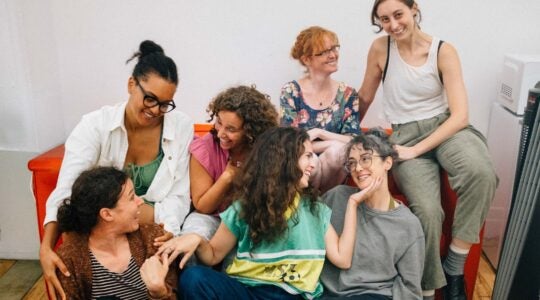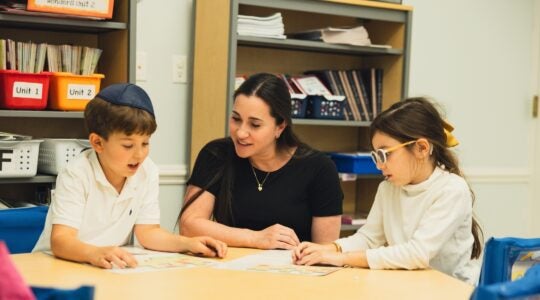What is the Other?
The original Hegelian notion of the Other, that of separateness and alienation, was adopted by social scientists to theories of group prejudice, where the Other is any person (or group) “other” to that person. The Other is different, therefore deviant, therefore alien to the society.
The classic Other in Judaism is, of course, the non-Jew. Even when the non-Jew changes his status — becomes a proselyte — there often remains a tinge of “otherness.” JournalWatcher has noted a number of recent treatments of this curious phenomenon. Notable is Marc D. Angel of the Institute for Jewish Ideas and Ideas, who sets a context for the larger discussion of conversion in “Conversion to Judaism: Halakha, Hashkafa, and Historic Challenge” (Hakirah, Winter 2009).
Angel’s article is a useful conspectus of giyur (conversion) and the ger (convert). But the author’s starting point is a counterintuitive one, counterintuitive for a person who is himself a key player, indeed a lightning rod, for the Modern Orthodox rabbinate in its battles with the Israeli Chief Rabbinate over conversions. Angel reports on how efforts on the part of many in the 19th- and early 20th-century rabbinic leadership to retain Orthodox distinctiveness informed the rabbis’ view of conversion and of converts, a hard-line position that equates conversion with total commitment to observe mitzvot. Yes, some elasticity developed in the system; and yes, some sectarian rabbis were flexible — but conversion in many quarters resulted in the creation of a Jewish Other. Rabbi Angel’s historical and sociological analysis culminates with a number of prescriptions for ameliorating the current “conversion crisis,” including the plague of “Otherness.” Is anybody listening?
How Jews perceived “Others” in the Early Modern era was in many ways a function of how people in general were positioned religiously in European societies. A narrative of a woman who converted to Christianity in 17th-century Italy serves as the foil for a fascinating exploration by Kim Siebenhüner (University of Basel) of the boundaries — literal and figurative — in the religious and social life of the time. In “Conversion, Mobility and the Roman Inquisition in Italy Around 1600” (Past and Present, August 2008), Siebenhüner reminds Journal Watcher that there were precious few opportunities for people to live between religious worlds: one was either a Jew or a Christian. You could not exist in both — or in none. There was no neutral space — except, perhaps, for some conversos — those who converted in 14th- and 15th-century Spain as result of Catholic pressure and who in some cases retained a measure of their Jewishness in secret ritual observance.
Marianna di Fiori’s story is unremarkable, except in those instances in which it is truly remarkable: a convert by force, she lived as a Christian, reconverted to Judaism and then returned to Catholicism. Di Fiori lived in and between two religious worlds; her religious identities were multilayered and ambiguous. It mattered not: di Fiori was treated as the Other by both Jews and Christians. The lesson: in the pre-Modern world there was no neutral space, there was no escaping “Otherness.”
Bringing the question of the Other to contemporary Israel, Journal Watcher notes that in recent years social, economic, religious and ethnic gaps have widened throughout Israeli society: haredim (fervently Orthodox) and chilonim (secular Israelis); haredim and the rest of the Orthodox world; Ashkenazi and Sephardi; Jew and Arab; and, more recently the newly minted class of the mega-rich, and everyone else. Two recent articles exploring situations very different one from the other look at the dynamics of group conflict and “otherness” in Israel. Bar-Ilan University’s Stuart Cohen, in “Tensions Between Military Service and Jewish Orthodoxy In Israel: Implications Imagined and Real” (Israel Studies, Spring 2007), punctures some conventional-wisdom balloons about the central institution of Israeli society — the Israel Defense Forces (IDF) — with respect to the IDF’s role in breaking down social barriers.
“Conventional wisdom has long asserted,” says Cohen, “that religion plays an integrative role in Israeli military service, thereby contributing to cohesion within the ranks.” A myth, argues Cohen: In point of fact, the IDF experience (with some very few exceptions) is one that enhances the social gaps in the society. In a word, the Other is often even further removed and isolated in the society as result of the army experience. Who would have thunk it?
A different slice of Israeli society is analyzed by three Israeli academics — Shifra Sagiv (Ben-Gurion University), Ariel Ayalon (The Migdam Project) and Khansaa Diab (David Yellin Academic College) — in “Perceptions of the Narrative of the ’Other’ Among Arab and Jewish Adolescents in Israel: Between Peace Talks and Violent Events” (Intercultural Education, April 2011). It has been long recognized that one of the major challenges to the peace process “is to overcome the rigid structure of the social-psychological repertoire that accompanies it.” In plain English: how does each — Arab and Jew — understand the reactions toward each other’s historical narrative? The authors collected data on this question over a nine-year period from a substantial number of Arab and Jewish high school students. The findings? “Among Jewish adolescents, the readiness to legitimate Palestinian narratives significantly decreased during violent periods.”
So tell me something I don’t know. Journal Watcher learned, however, that for the Arab students, their minority status — a status of Other in Israel — is reflected in their high level of readiness to accept both narratives, Arab and Jewish. For Israeli kids, the “contact hypothesis” — the more contact you have with the “other,” the more empathy you have — was trumped by Arab-generated violence. The Arab adolescents, however, “have succeeded in expressing their own unique identity, which has been different from both Israeli and [non-Israeli] Palestinian identities.” Their experience as a minority — an Other — has enabled them to be open to the other other’s (that is the Israelis’) Jewish narrative.
Once again, is anybody out there paying attention?
Jerome A. Chanes is the author of four books on Jewish public affairs and organizations. Forthcoming is “The Future of American Judaism,” a volume in the “Future of American Religion” series (Trinity/Columbia University Press).
The New York Jewish Week brings you the stories behind the headlines, keeping you connected to Jewish life in New York. Help sustain the reporting you trust by donating today.




